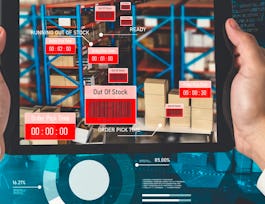In the Implementing Supply Chain Analytics: Descriptive, Diagnostic, Predictive and Prescriptive course, you’ll discover how implementing analytical methods, models, and tools helps decision-making become more efficient. You’ll use different types of methods, models, and tools, depending on specific business scenarios or needs, to help you analyze the current state of the supply chain and to lead you to insightful solutions. You’ll also explore the utilization of supply chain models to evaluate and question the data to optimize the flow of goods, information, and cost in a supply chain to help identify potential improvements, determine the most efficient or practical course of action, and to communicate the impact to the customer.



Implementing Supply Chain Analytics
This course is part of Unilever Supply Chain Data Analyst Professional Certificate

Instructor: Unilever Team
2,317 already enrolled
Included with 
(25 reviews)
Recommended experience
Skills you'll gain
Details to know

Add to your LinkedIn profile
19 assignments
See how employees at top companies are mastering in-demand skills

Build your Data Analysis expertise
- Learn new concepts from industry experts
- Gain a foundational understanding of a subject or tool
- Develop job-relevant skills with hands-on projects
- Earn a shareable career certificate from Unilever


Earn a career certificate
Add this credential to your LinkedIn profile, resume, or CV
Share it on social media and in your performance review

There are 4 modules in this course
In this module, you will learn how programming languages such as Python and SQL assist in managing, cleaning, summarizing and manipulating data.Communicating Diagnostic Analytics You will also learn how to use programming languages to create meaningful data visualizations.
What's included
16 videos6 readings3 assignments1 discussion prompt
Data analytics is the practice of examining data to answer questions, identify trends, and extract insights. In this module, you will focus on the four levels of data anlytics that help answer questions about what happened and why, what might happen in the future, and what are the possible outcomes.
What's included
15 videos11 readings6 assignments1 discussion prompt
There are several different types of Supply Chain models. Once you know the probem your trying to solve, you can select the type of model that will best help you find a solution. In this module you will learn how use the inventory model to describe inventory policies, inputs and outputs, operations related to inventory management, how to use the continuous flow model to describe the current state and current practices in the business operations to identify opportunities for improvement, and how to use the fast chain model to describe the current state and current practices in the business operations to identify opportunities for improvement.
What's included
11 videos5 readings4 assignments
There are several different types of Supply Chain models. Once you know the probem your trying to solve, you can select the type of model that will best help you find a solution. In this module you will learn how use the efficient chain model to identify optimal scenarios and best practices that could be translated into other environments, use the agile model to prepare for participating in cross-functional developments driven by the supply chain, use the custom-configured model to prepare cross-functional developments driven by the supply chain with a more flexible infrastructure to new projects or developments, and use the flexible model to build flexible structures and scenario planning.
What's included
7 videos22 readings6 assignments
Instructor

Offered by
Recommended if you're interested in Data Analysis

Unilever

Coursera Project Network

Coursera Project Network
Why people choose Coursera for their career




Learner reviews
Showing 3 of 25
25 reviews
- 5 stars
80%
- 4 stars
8%
- 3 stars
4%
- 2 stars
4%
- 1 star
4%
Reviewed on Jul 22, 2024
New to Data Analysis? Start here.

Open new doors with Coursera Plus
Unlimited access to 7,000+ world-class courses, hands-on projects, and job-ready certificate programs - all included in your subscription
Advance your career with an online degree
Earn a degree from world-class universities - 100% online
Join over 3,400 global companies that choose Coursera for Business
Upskill your employees to excel in the digital economy
Frequently asked questions
Access to lectures and assignments depends on your type of enrollment. If you take a course in audit mode, you will be able to see most course materials for free. To access graded assignments and to earn a Certificate, you will need to purchase the Certificate experience, during or after your audit. If you don't see the audit option:
The course may not offer an audit option. You can try a Free Trial instead, or apply for Financial Aid.
The course may offer 'Full Course, No Certificate' instead. This option lets you see all course materials, submit required assessments, and get a final grade. This also means that you will not be able to purchase a Certificate experience.
When you enroll in the course, you get access to all of the courses in the Certificate, and you earn a certificate when you complete the work. Your electronic Certificate will be added to your Accomplishments page - from there, you can print your Certificate or add it to your LinkedIn profile. If you only want to read and view the course content, you can audit the course for free.
If you subscribed, you get a 7-day free trial during which you can cancel at no penalty. After that, we don’t give refunds, but you can cancel your subscription at any time. See our full refund policy.


